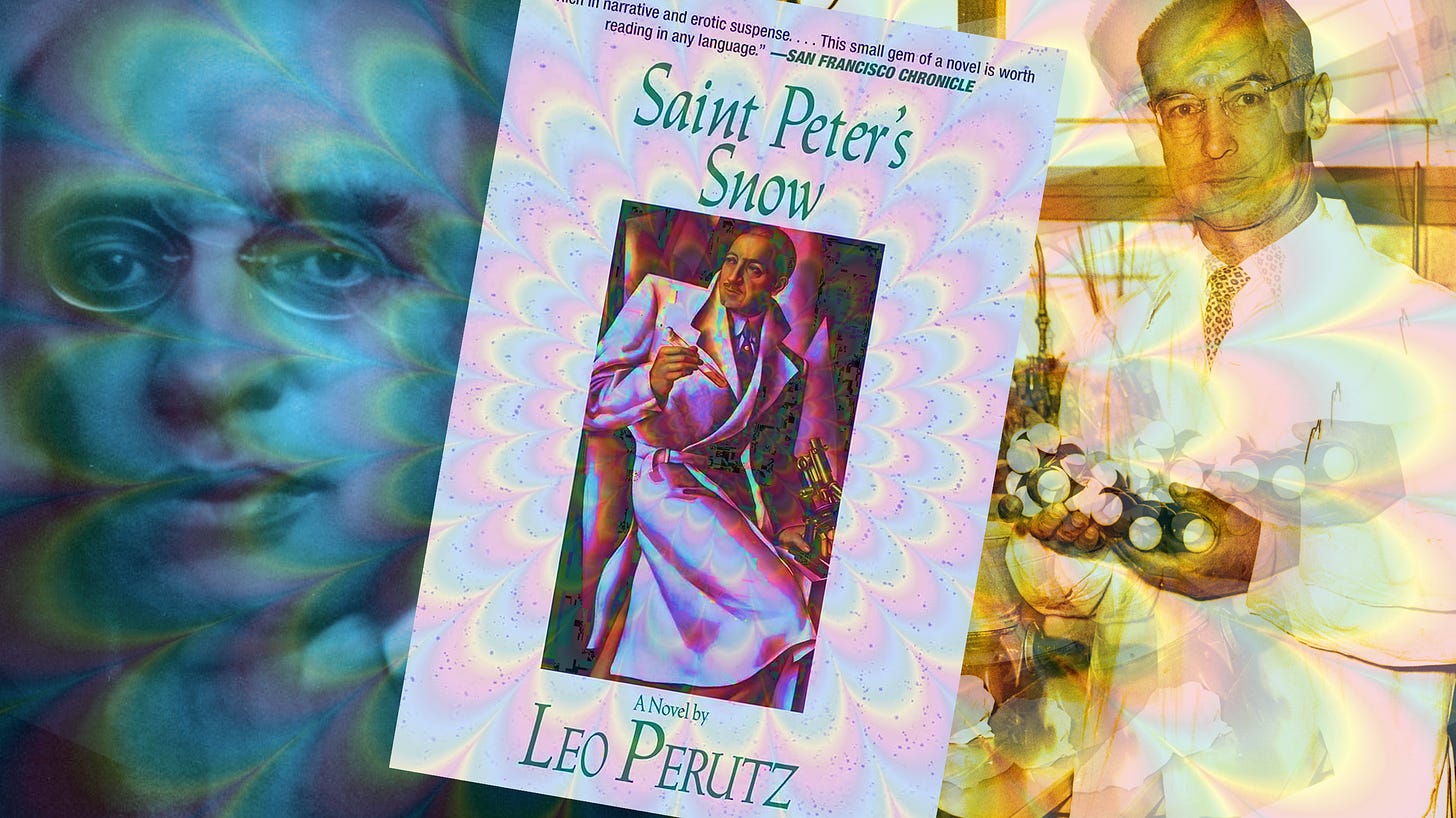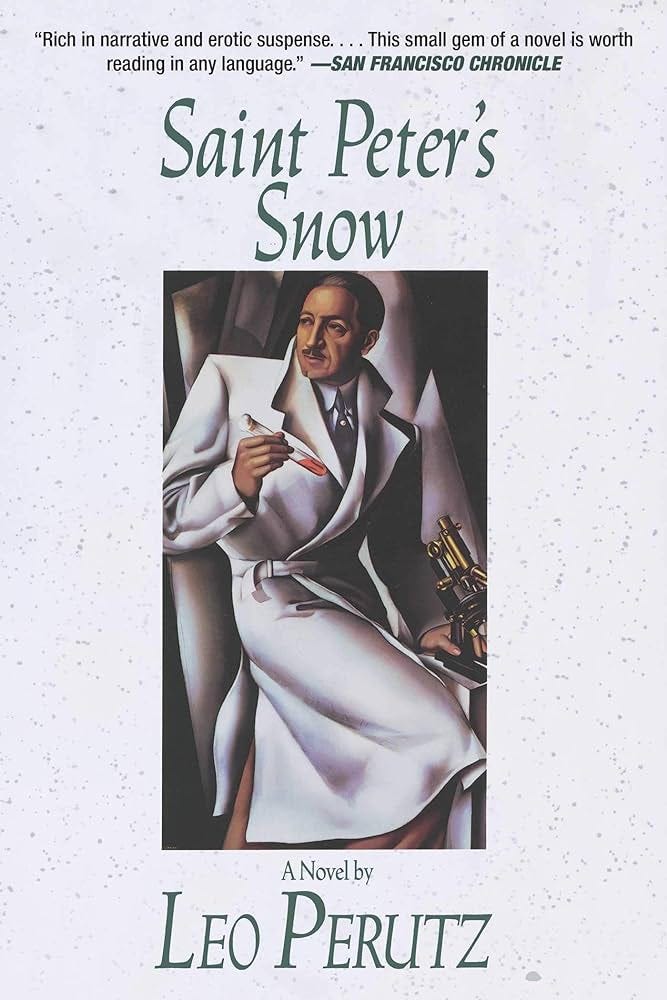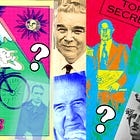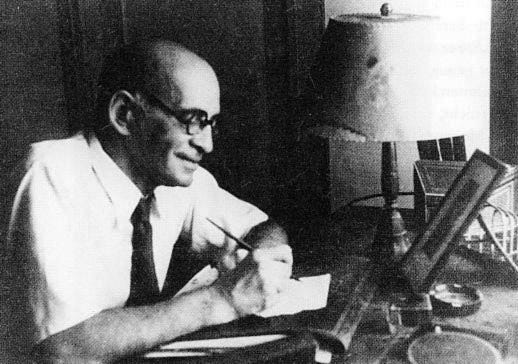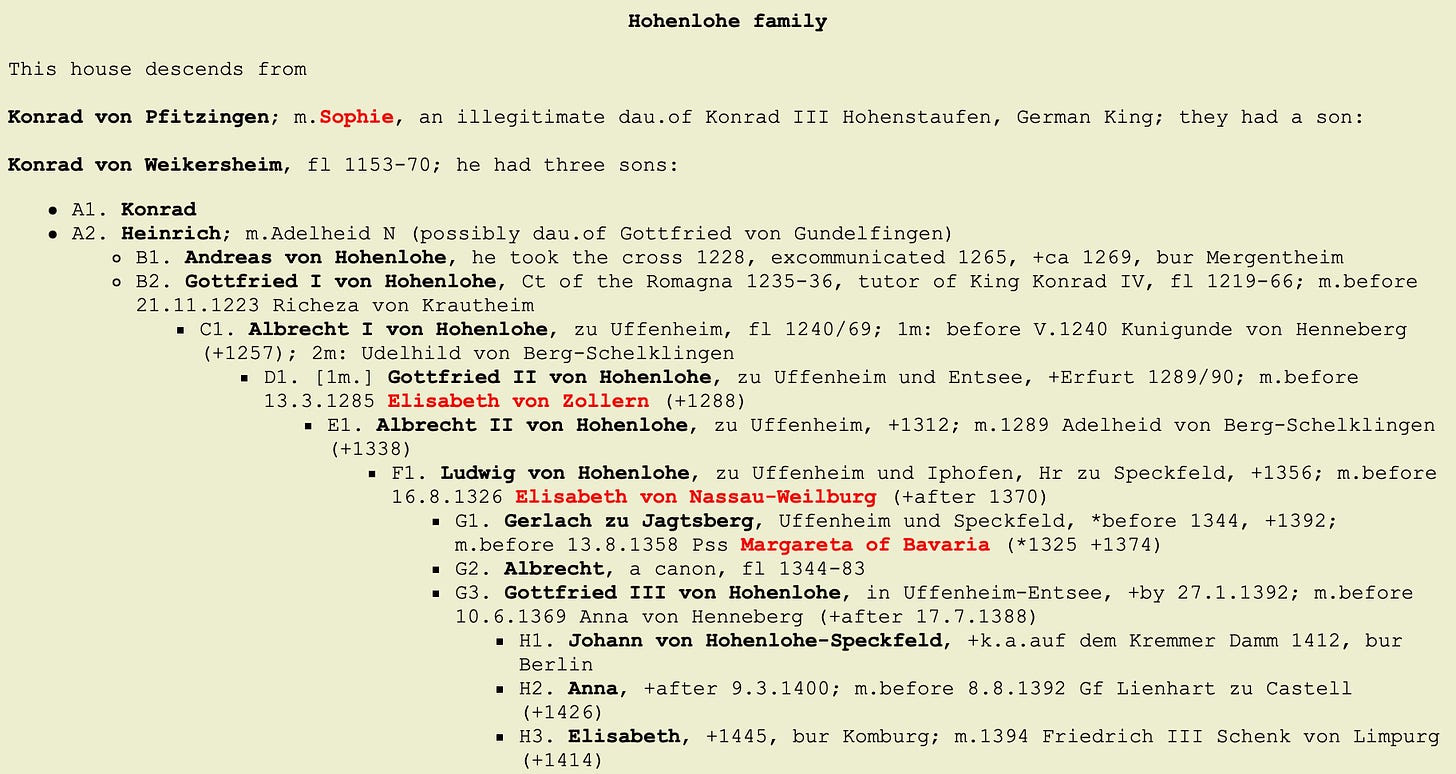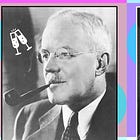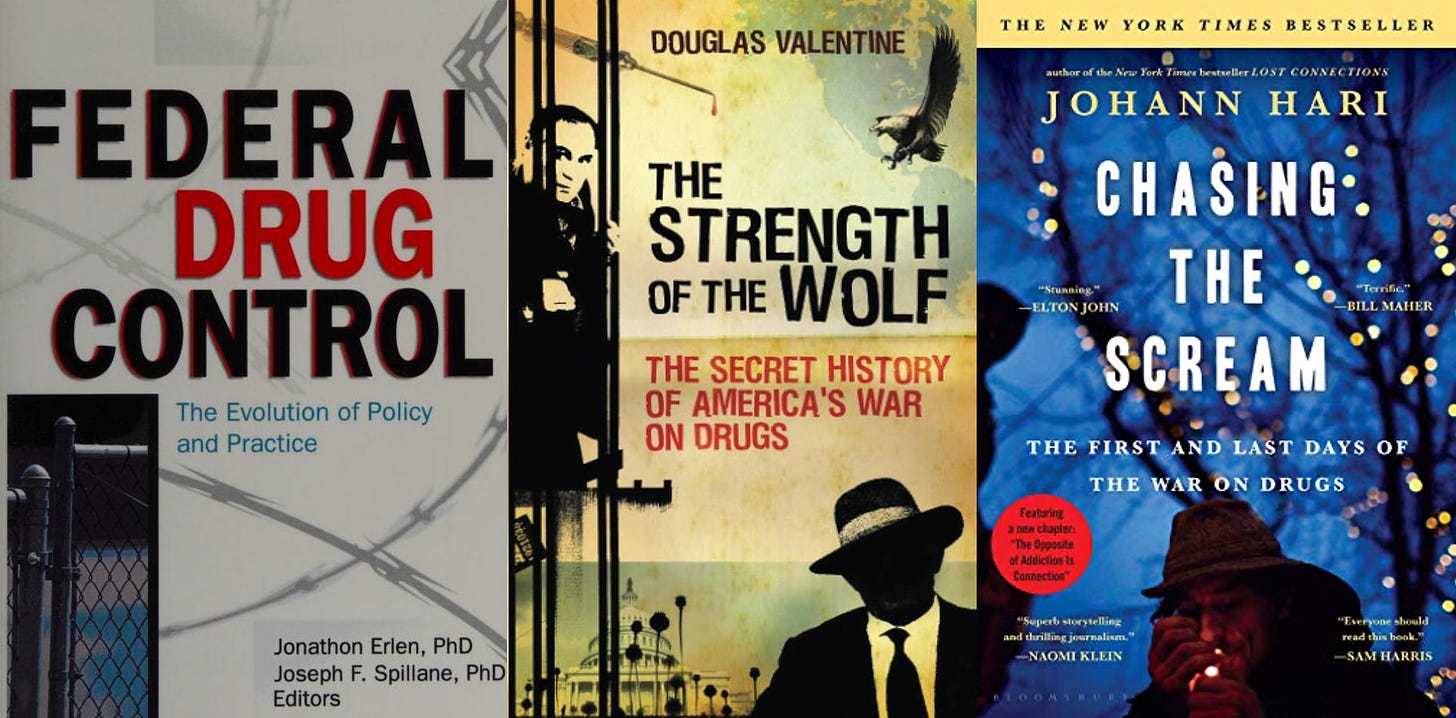A prophetic acid novel from the 1930s
Deciphering Saint Peter's Snow and the protopolitics of LSD
Years before the invention of LSD, an Austrian writer named Leo Perutz published an intriguing novel whose basic storyline eerily prophesied the rise of acid and the complicated politics around it. Titled Saint Peter’s Snow and originally published in German in 1933, Perutz’ novel and the sociopolitical circumstances of its publication are well worth examining for casual acidheads and LSD history buffs alike. (It would also make a fucking great movie…)
I’ve described Pertuz’ book as an “acid novel” in the sense that it portrays the use of psychoactive ergot alkaloids, a number of which are, chemically speaking, acids and can therefore be loosely described as “acid” with some sense of etymological integrity. To be clear, I am not suggesting that Perutz’ book is specifically about LSD, because LSD was not synthesized until a few years later. But, as we’ll see, the history of ergot (from which LSD is derived) was already quite well developed—if also carefully concealed—when Perutz’ visionary novel was written.
Alan Piper has already done extensive research into the possible sources of inspiration for Perutz’ mysterious novel. While his work has focused on the European side of things, in this piece I will introduce a couple of prominent names from the US-based War on Drugs—specifically, Allen Dulles and Harry Anslinger—and consider how their experiences in Europe during and after World War I may or may not have played into the series of events depicted by Perutz in his novel. (We’ll even see how the Bush family ties into all this.)
I will also expand on Piper’s research by introducing some information about Franz Kafka which might help us further understand the social context in which Perutz’ novel was produced. Lastly, I’ll connect themes from Saint Peter’s Snow to a much older history of ergot and its relationship with the hegemony of the Church in Europe. Considered within this context, the psychological drama that unfolds in the book is itself a breathtaking story worthy of attention from advocates, policymakers, scholars, screenwriters, film studios, etc.
A Brief Synopsis
The plot of the novel is itself somewhat complex and nuanced, especially considering the book’s rather brief length. Although I’d love to expound upon the finer points of Perutz’ plot (and probably will in a future post), for now allow me to offer a simple nutshell synopsis.
The story follows a doctor named Georg Friedrich Amberg who is hired by a wealthy figure named Baron von Malchin to assist with an extended medical experiment. The project involves the use of an alkaloid extracted from ergot mold from contaminated rye grain. The true motivations of the experiment are not initially revealed to Amberg however, and he only figures out what he’s involved in after becoming totally embroiled in it.
As it turns out, the Baron who hired Amberg represented an extended network of wealthy Europeans descended from noble and aristocratic families. (Notably, Perutz chose to the use real names of actual noble families, such as the Tudor dynasty, in the book.) In Perutz’ novel, these families plan to utilize the ergot alkaloid to induce a mass spiritual conversion experience which—they hope—will convert the rabid masses into docile, obedient serfs and thus allow the aristocracy to restore the Holy Roman Empire in Europe.
But their plan backfires, and the first population subjected to their experiment revolts in a quasi-Marxist uprising. The story then cuts to a later date. The doctor finds himself awakening from a coma in a hospital. Upon confronting his nurses about his experience, he is told that nothing of the sort ever happened and that he wound up in the hospital after a car accident. He is essentially gaslit into doubting his own direct experience, only to then receive a final clue which seems to confirm his suspicions.
Shortly after the book’s publication, Perutz’ publisher was banned by the Nazis.1 A few years later, Perutz fled Austria, and although he enjoyed a decent reputation during his lifetime, his work has become more obscure in the decades since his death. Meanwhile, a stunningly similar chain of events to those portrayed by Perutz played out in real life. And they were instigated by individuals who were themselves connected, in various ways, to the same royal European families that figure into the book.
From Diplomats to Drug Warriors: The US Network
A cast of real-life characters from the United States bear some strange connections to the same aristocratic families mentioned in Perutz’ novel. Oddly enough, a handful of these individuals played key roles in not only the development of the War on Drugs but also MK-ULTRA and similar state-backed Cold War drug experiments.
In my research of the CIA’s extended professional network, I’ve come across some intriguing links between Allen Dulles, Harry Anslinger, the Bush family, and the noble dynasties mentioned by Perutz in his novel, namely the Hohenstaufens and the Tudors.
Allen Dulles
Let’s start with Allen Dulles. While he is most known for his tenure at the helm of the CIA in the 1950s and ‘60s, Dulles’ involvement with the government actually predated the CIA by many years. His prominence in government circles owes largely to the political influence of his family. His grandfather, John Foster, served as Secretary of State under President Benjamin Harrison.
Through his grandfather, the young Allen and his brother John became intimately involved in diplomatic activities. Allen was invited to Vienna in 1916 to witness and take part in diplomatic negotiations that his family was involved in. It was in this period that Dulles became acquainted with the Hohenlohe family.
The connection was made through Maximilian Egon von Hohenlohe, who met Dulles in Vienna. Over time, Dulles worked somewhat closely with the Hohehlohe family, ultimately forging a relationship that lasted for years, through at least the 1940s.2 With a little digging, I found out that the Hohenlohe family are descended from an ancestor who was supposedly an illegitimate daughter of a Hohenstaufen. To reiterate, the Hohenstaufens are among the network of aristocratic families depicted in Perutz’ novel who try to restore their power via strategic use of drug-induced ecstasy
Dulles grew closely connected to the German elite after acquainting himself with the Hohenlohes. In the 1930s, he worked for Sullivan and Cromwell, a New York-based law firm that collaborated extensively with Nazi-aligned businesses. Dulles himself met Adolf Hitler on at least one occasion, and the staff at Sullivan and Cromwell were known to sign letters to their German partners with “Heil Hitler.” [Note: A more recent alum of Sullivan and Cromwell is Peter Thiel, who has collaborated with the CIA and also funded a psilocybin-focused pharmaceutical firm, Compass Pathways.]
As I’ve explored elsewhere, such ties between various factions within Germany and the US were themselves elemental to the development of the psychedelic industry after World War II. Dulles later helped create the Central Intelligence Agency (CIA) and became the agency’s director in 1953. It was under Dulles’ reign that the agency launched MK-ULTRA, much of which revolved around LSD. A number of Nazi scientists who were hired by the US through Dulles’ political connections assisted the Agency in its quest to find pharmacological techniques for mental and social control.
Harry Anslinger
A young Harry Anslinger was also involved in covert diplomacy with Germany in the same period. He later became an architect of the War on Drugs, which coexisted (and coexists) in a delicate balance with the state-backed psychedelic industry.
Anslinger, who “spoke fluent German,” began working for the government as soon as he graduated college (Penn State, class of 1915).3 He held a number of positions for different agencies, ranging from the Pennsylvania State Police to the US State Department. He also worked as a clerk at the War Department, the precursor to today’s Department of Defense.4
Keep reading with a 7-day free trial
Subscribe to High and Mighty to keep reading this post and get 7 days of free access to the full post archives.




